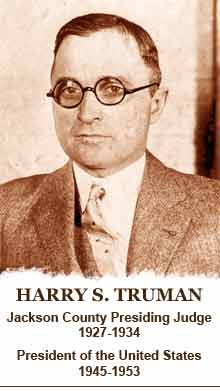Our History
County History
On December 15, 1826, the Missouri State Legislature authorized the "County of Jackson," named after the seventh president of the United States of America, Andrew Jackson. A year later, the first courthouse was built in Independence by Daniel P. Lewis for $150. From those humble roots, in what is now Independence, Missouri, sprung Jackson County’s government.
In 1836, the first permanent, brick Jackson County Courthouse was erected on Independence Square in Independence, the County Seat. That building, now commonly known as the "Truman Courthouse" has since undergone five major remodels.
Truman Years

In 1926, Harry S. Truman was elected Presiding Judge of Jackson County and was instrumental in voter approval of a major bond issue that made possible the adoption of a County "Ten Year Plan." The plan called for a new courthouse in downtown Kansas City plus remodeling of the Independence Courthouse, a juvenile center, improvements at the Jackson County home, and modernization of roads and bridges.
President Truman left a decorating legacy behind that began in Kansas City. In fact, his design savvy helped make Kansas City become known as the nation's top 10 city for art deco buildings. Truman traveled the country at his own expense to locate a design for the courthouse, which he found in Louisiana. The Jackson County Courthouse still stands tall and remains a well-known landmark in Kansas City.
Construction of this 300-foot building began July 17, 1933. The courthouse was dedicated in 1934, the same year that Truman left County government to become a U.S. Senator. Harry S. Truman went on to become the 33rd President of the United States.
Historical Research
For more information or background about Jackson County, please visit the Jackson County Historical Society, a nonprofit organization dedicated to the preservation and understanding of the County’s heritage in an effort to promote the study, appreciation and interpretation of local and regional history.